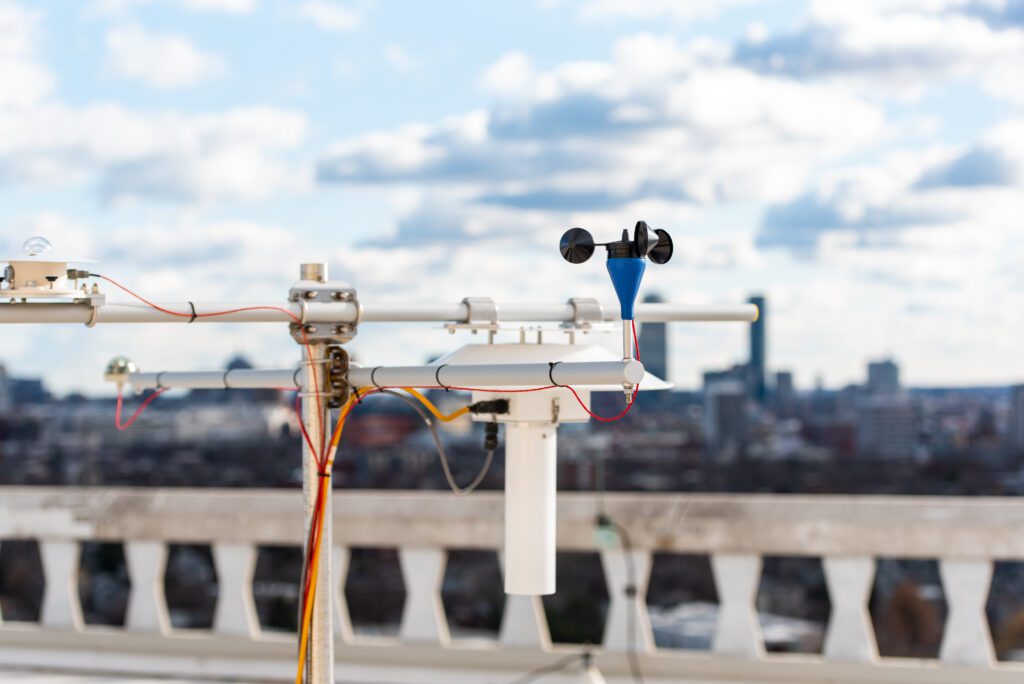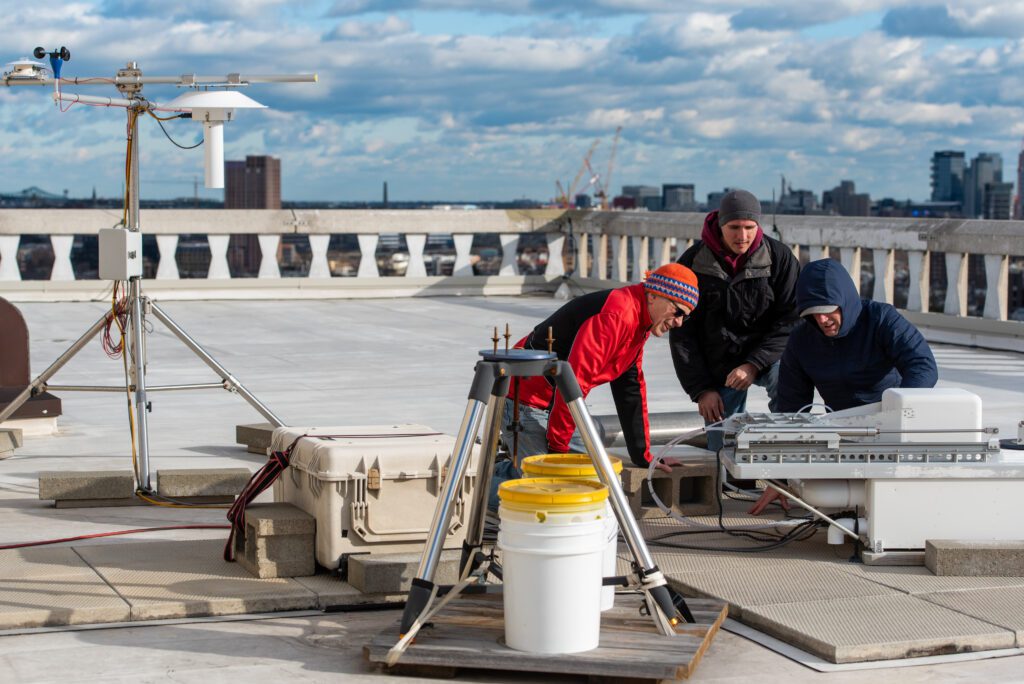Quantifying Methane – To the Sky and Beyond
Several years ago, Maryann Sargent and John Budney, a research scientist, and a research technician in the Wofsy-Munger Group, took Ph.D. student Kathryn McCain’s years’ worth of urban atmospheric gas measurements and used them to calculate methane emissions levels across Boston. They found that there was no significant decrease in Boston’s methane emissions between 2014 and 2020, in spite of local policies to reduce methane leaks from gas pipelines.
“We actually started this study thinking we want to show gas companies how important it is to reduce pipeline leaks,” Maryann Sargent said, “and we ended it saying we need to get off natural gas as fast as we can because efforts at reducing pipeline leaks aren’t making a big difference.”
Compelled by Sargent and Budney’s initial results, the Wofsy-Munger Greenhouse Gases and Biosphere-Atmosphere Exchange Group at Harvard University went on to find that methane emissions in the Boston area were two to three times higher than what was represented in the U.S. Environmental Protection Agency’s inventories. There were numerous possible sources of these leaks in the methane chain, including poorly adjusted heating appliances or commercial cooking facilities.
“It would be desirable to clean some of that up, but it’s really a difficult task,” Wofsy said. “You’re basically saying you need to re-engineer the whole system.”

As an extension of this measurement study, Jonathan Franklin, a research associate with the Wofsy-Munger Group, deployed a spectrometer for the group that can probe an entire atmospheric column of air. By putting a spectrometer both upwind and downwind of a methane source, the researchers have been able to identify measurable differences between them and capture true methane emissions levels.
With this new technology in hand, the researchers began strategically placing spectrometers to create a broader regional picture of methane emissions. The group began by first installing spectrometers on the roof of William James Hall in Cambridge and in the Harvard Forest.
The Wofsy-Munger Group started to expand its network of these column measurements in 2016. In one study, the researchers set up five spectrometers around the perimeter of Indianapolis, Indiana to better understand the total methane emissions from the city, which were higher than bottom-up methods of methane measurement.
“We have also had some great successes implementing this method around dairy farms east of Los Angeles,” Franklin said. On these farms, they found strong variability in emissions based on weather and season, which could help inform better methane emissions policy in animal agriculture.
While exploring methane footprints across large metropolitan areas, the Wofsy-Munger Group began considering the possibility of collecting such data on a national or even global scale. What might it look like to capture emissions data on an entire oil or gas drilling province? This kind of information could help to improve our understanding of greenhouse gas emissions and help in tracking the progress of climate change. However, the ground-based spectrometer technology they had developed and used up until that point wasn’t capable of capturing data at such a large scale.
So, the group took to the skies.

MethaneSAT, an airborne and satellite-based methane measurement project, came about in 2015 with an exciting call from the Environmental Defense Fund (EDF). EDF asked the Wofsy-Munger Group if it could create a satellite measuring global methane and carbon dioxide emissions. Specifically, EDF wanted to build upon data EDF had already collected from oil and gas sites in the United States. The existing data showed two to three times more emissions than what was reported in emissions inventories.
At the time, satellite technology could either provide global daily methane measurements with limited spatial resolution, or provide precise emissions in one place, but only measure individual emissions sources at one time. A technology that did both would represent a breakthrough. The Wofsy-Munger Group got to work creating an innovative new satellite that would be able to do just that — and in higher resolution than existing satellites. The group collaborated with Kelly Chance, Xiong Liu, Peter Cheimets, and Jenna Samra at the Harvard & Smithsonian Center for Astrophysics and determined that the total cost of building this innovative new technology would cost $30 million.
“I thought that was the end of it,” Wofsy said, “30 million dollars is a lot for a group like EDF, but it turns out private philanthropy is interested in pushing forward a climate-friendly agenda.”
In the end, EDF raised $100 million to fund the creation of this new satellite technology. Today, its construction is complete. The satellite is now undergoing testing with a launch planned for sometime in January 2024. The new satellite will measure sites that are up to 200 kilometers wide while maintaining the ability to observe individual emissions spots with the granularity of an area as small as 100 meters wide.
To take full advantage of this satellite’s groundbreaking capabilities, however, the group knew it would need more data before launch. As part of the initial satellite planning, the researchers discussed the idea of having an airborne simulator that could perform remote sensing. With support from the National Science Foundation and EDF, the group was able to build a successful airborne measurement device. Later, with the support of $10 million from EDF, the Munger-Wofsy Group launched a parallel airplane-based measurement program called MethaneAir.
The first stage of MethaneAir entailed nine flights in 2021 and four flights in 2022, which allowed the researchers to refine the algorithms and data analysis used by MethaneSAT. A new MethaneAir flight campaign began in May 2023 to map all oil and gas basins in the United States, Canada, and Mexico. Mapping and emissions measurements from the flights will give the team more information about emissions sources in North America and prepare the data analysis for the satellite campaign launch next year.
Most other satellite-based methane missions seek simply to measure the concentration of methane in the atmosphere. “That is not the nature of this mission,” Franklin said. “Not only do we measure the concentration, but we also then determine the emission rate that caused those concentrations in the atmosphere.”
The methane emission data information from both MethaneSAT and MethaneAir will be utilized by a large advocacy team that EDF has assembled. Their job? To take the data and work with stakeholders and communities on the ground to reduce methane emissions in high-emission zones. The program is shooting for a 45% methane emissions reduction by 2025 and a 75% reduction by 2030. MethaneSAT’s potential for scientific advancement led TIME Magazine to name it one of the Best Inventions of 2022.
The Wofsy-Munger team plans to help translate this new data from both MethaneAir and MethaneSAT into critical policy and regulatory recommendations through a new project funded by the Salata Institute’s Climate Research Clusters Program. The project involves faculty from Harvard Law School, Harvard Kennedy School, the Harvard T.H. Chan School of Public Health, Harvard Business School, and the Harvard Faculty of Arts and Sciences. By working with these colleagues, “who are deeply focused on the regulatory environment at the state and federal levels,” Wofsy said, “we’re hoping that the connection will strengthen our ability to have a profound impact.”
